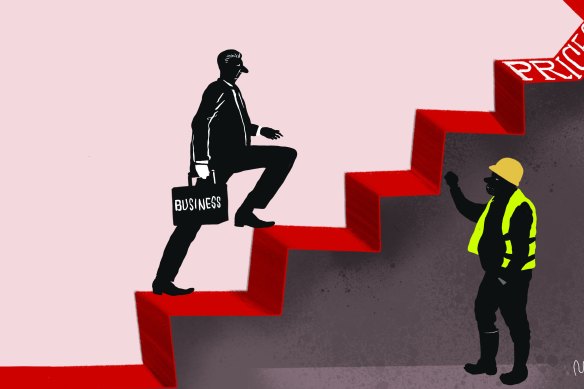As for the cyclical-versus-structural distinction, it’s relevant because, as Lowe never tires of reminding us, monetary policy is capable of dealing only with cyclical problems. Its role is to smooth the ups and downs in demand as the economy moves through the business cycle.
But here’s the problem:
In particular, employees and their unions now have less power to insist on wage rises sufficient to keep up with price rises than they did when last we had a big inflation problem. But big business now has more power to raise its prices.

Credit:Illustration: Matt Davidson
Partly because globalisation has moved much manufacturing from the high-wage advanced economies to China and other low-wage economies, and partly because of the decentralisation and deregulation of wage-fixing and the decline in union membership, most workers pretty much have to accept whatever inadequate pay rise their chief executive (or premier) chooses to give them.
This is why all the concern about inflation expectations becoming “unanchored” is so silly. Businesses have the power to act on their expectations of higher inflation, but workers no longer do.
This is why the rate of unemployment can fall far below what economists, using data going back decades, estimate to be the NAIRU – “non-accelerating-inflation” rate of unemployment – without wage inflation accelerating.
In concentrated markets, firms can also easily see the effects on their few competitors, and they can watch and follow each other’s behaviour. They are confident that none will break ranks on price rises because there are benefits to be had by all.
When thinking about inflation, macroeconomists – including Lowe, I suspect – often assume our markets are competitive, and that the markets for all goods and services are equally competitive.
But as Rod Sims, former chair of the Australian Competition and Consumer Commission, and now a professor at the Australian National University, has written, markets in Australia are generally far from strongly competitive.
Loading
“Many sectors … are dominated by just a few firms – think beer, groceries, energy and telecommunications retailing, resources, elements of the digital economy, banking and many others,” Sims says.
“This means the dominant firms have some degree of market power. That is, they can set prices at higher levels knowing competitors are unlikely to undercut them and take market share from them.
“When there is high inflation, dominant firms often realise they can increase prices above any cost rises because consumers will be more accepting of this. They will often do this subtly over time.”
In concentrated markets, firms can also easily see the effects on their few competitors, and they can watch and follow each other’s behaviour. They are confident that none will break ranks on price rises because there are benefits to be had by all.
Firms with market and pricing power are also less likely to restrain prices in response to interest rate rises, Sims says. This is because it’s not competition, but dominant-firm behaviour, that’s driving pricing decisions.
As well, market power is usually associated with reduced production capacity. How often do we see reductions in combined capacity following a merger of two competitors? When demand increases, there’s then less capacity available to serve it, so we see prices rise more than they otherwise would have.

Interest rates can only do so much to fight against inflation. Credit:Louie Douvis
What all this means is that it may take longer for interest rates to work to slow inflation, so patience may be needed rather than further increases. And, Sims says, there could be a role for publicly exposing high margins, to put pressure on to reduce them.
Another point he makes is this inflation owes much to price shocks in the key, highly regulated gas and electricity industries. In these cases, the best answer is to make their regulation more anti-inflationary, not just jack up interest rates further.
The micro-economic reforms of the Hawke-Keating government have made our economy much less inflation-prone than it was in the days when inflation was last a major problem.
Loading
Meanwhile, however, we’ve allowed the pricing power of big firms to grow as successive governments of both colours have resisted pressure from people like Sims to tighten our merger law, and state governments have maximised the sale price of their electricity businesses by selling them to business interests intent on turning the national electricity market into a three-firm vertically integrated oligopoly. Well done, guys.
Ross Gittins is the economics editor
The Business Briefing newsletter delivers major stories, exclusive coverage and expert opinion. Sign up to get it every weekday morning.
For all the latest Business News Click Here
For the latest news and updates, follow us on Google News.
